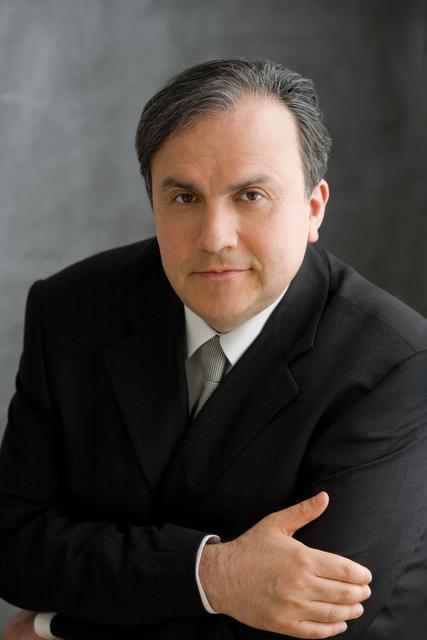Bronfman stokes a Russian storm in Prokofiev’s “War” sonatas
Prokofiev’s piano sonatas are an outstanding body of work, music that tests the limits of sonata form, dusting off and polishing up old ideas for a modern age. They are structurally and thematically inventive, full of energy, intellect, and complex emotions.
The pinnacle of the ten sonatas is the group of “War” sonatas, No. 6, 7, and 8. Prokofiev began these in 1939, and they were finished in 1940, 1942, and 1944, respectively. The title is circumstantial but fitting—despite the first being completed before war reached Russia, they are closely related by mood and expression, and even share some structural ideas.
Yefim Bronfman played the three sonatas Saturday night at Carnegie Hall, an installment in a series of Prokofiev recitals he is giving there this season. Bronfman is one of the great interpreters of the sonatas, a peer in this music and natural successor in the line that descends from Emil Gilels and Sviatoslav Richter. His astonishing playing Saturday night affirmed that.
The sonatas are notoriously difficult pieces for a pianist. Played well, their challenge to the listener is their intensity, the disorienting alternation between extreme, even violent, angularity, and a pastoral introversion.
Bronfman has the emotional musical temperament that can range from wistful to explosive, and a technique that can handle the fingering and the speeds—in fact Saturday he frequently pressed tempos to tension-inducing heights.
While on the surface, Sonata No. 6 matches tradition sonata form, Prokofiev stretches every structural idea to the limit. The opening bars, with a staggered rhythm in the right hand over crashing octaves in the left, the base moving by a tritone, are like a violent drunk trampling his way down the street.
The siren call for a pianist in this music is a kind of demented exaggeration, and Bronfman, despite the physical power of his playing, actually maintained an exact sense of rhythm and phrasing. With this, he brought out the expressive strangeness of the secondary theme and the transitional material. The return of the opening theme was not just loud and exciting, but conditioned by a transformative understanding of the intervening music. It was a sonata-allegro movement played with respect for the form, and brilliantly realized in this performance
This is music about conflict, and World War II is there, certainly. But abstracted through the music, something else comes through—that quality unique to Prokofiev of setting pastoral against mechanical music. The conflict is between man and machine, and the explosively grim intensity at the end of the first two sonatas seems to say that the machines will win.
Conflict comes in unexpected places, like the Allegretto of Sonata No. 6, where it is colored by Prokofiev’s sarcasm. Bronfman’s touch here was light. Humanity shines fully in slow movements, like the waltz of No. 6, where Bronfman’s playing was soulful, with ideal phrasing.
The pianist’s range and depth of thought and feeling throughout the concert equalled that of the composer. There was something thrillingly sadistic about how much control he had over the notes, and how he channeled so much force through that. His fierce attack on the last notes of Sonata No. 6 literally threw himself back from the stool.
His performance of Sonata No. 7 was so astonishing that it produced involuntary cries from the audience at the last, pounding chords of the Precipitato movement. What must it be like to create abstract order when the world is burning around you? That is the sound of this sonata, and again Bronfman’s range was incredible—he played like a machine and like a penitent, capable of both love and murder.
The music has wild swings of stillness and violence, and Bronfman slowly accumulated a critical mass of unstable material. In the Precipitato, his left hand built a truly awe-inspiring amount of weight and tension, playing with a subtle swing and slowly ramping up the dynamic level and sense of violence. It was like the inevitable, steady approach of a pile driver, manned by Gene Krupa.
Sonata No. 8, which came after intermission, finds some measure of stability. Victory is on the way, as heard in the third movement, which has qualities both of an 18th century sonata and a triumphal march from a news reel. Bronfman blasted through this with spectacular vitality, but before that, the Andante Sognando was just as spectacularly plangent, a reflection back on disaster from a point of safety.
Bronfman played one encore, Schumann’s Op. 18 Arabeske. It was exceedingly gentle, understated, and expressively legato, and settled the mind and heart poignantly.
Yefim Bronfman and violinist Guy Braunstein play Prokofiev Violin Sonatas Nos. 1, 2, 5, and 9, 7:30 p.m. June 18, in Zankel Hall. carnegiehall.org.




Posted May 09, 2016 at 8:42 am by Barry Lyons
Nice review. That “involuntary cries” is great. I guess I missed hearing those, but I do recall that the audience seemed spellbound at that moment (at the end of the Seventh Sonata).
Your last paragraph is peculiar: Prokofiev only wrote two violin sonatas. You meant to write that the concert will be a mix of the two violin sonatas (both great works) AND other piano sonatas.